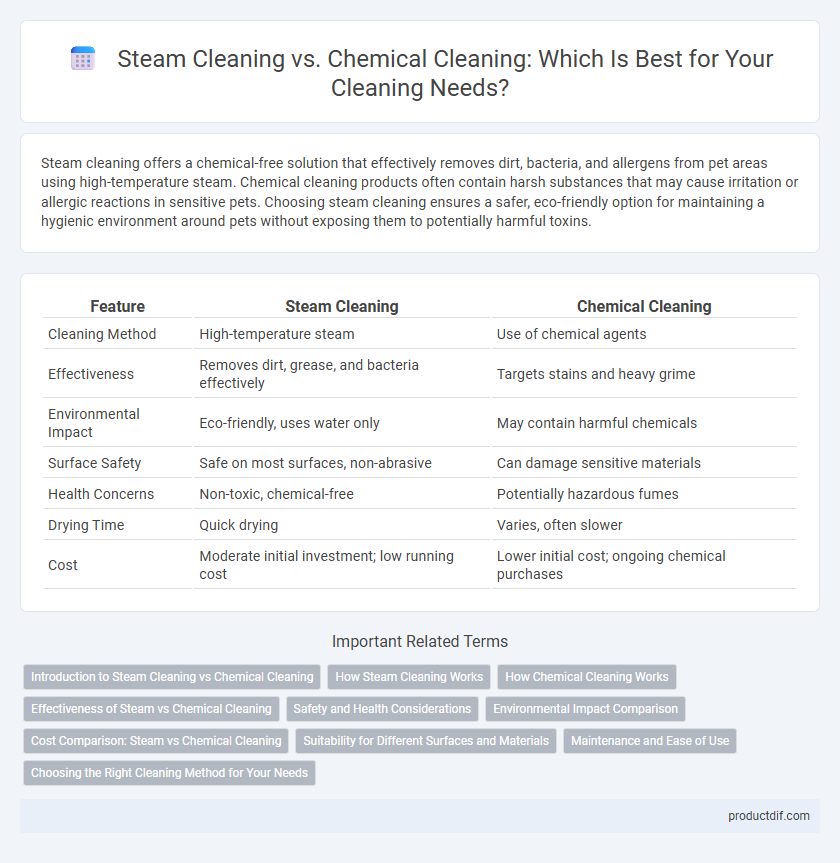Steam cleaning offers a chemical-free solution that effectively removes dirt, bacteria, and allergens from pet areas using high-temperature steam. Chemical cleaning products often contain harsh substances that may cause irritation or allergic reactions in sensitive pets. Choosing steam cleaning ensures a safer, eco-friendly option for maintaining a hygienic environment around pets without exposing them to potentially harmful toxins.
Table of Comparison
| Feature | Steam Cleaning | Chemical Cleaning |
|---|---|---|
| Cleaning Method | High-temperature steam | Use of chemical agents |
| Effectiveness | Removes dirt, grease, and bacteria effectively | Targets stains and heavy grime |
| Environmental Impact | Eco-friendly, uses water only | May contain harmful chemicals |
| Surface Safety | Safe on most surfaces, non-abrasive | Can damage sensitive materials |
| Health Concerns | Non-toxic, chemical-free | Potentially hazardous fumes |
| Drying Time | Quick drying | Varies, often slower |
| Cost | Moderate initial investment; low running cost | Lower initial cost; ongoing chemical purchases |
Introduction to Steam Cleaning vs Chemical Cleaning
Steam cleaning harnesses high-temperature vapor to disinfect and remove dirt without chemical residue, making it an eco-friendly option ideal for sensitive surfaces. Chemical cleaning employs detergents and solvents to dissolve grime and pathogens, offering strong cleaning power but potential environmental and health risks. Understanding these methods aids in selecting effective solutions based on surface type and cleaning requirements.
How Steam Cleaning Works
Steam cleaning uses pressurized hot water vapor to penetrate surfaces and dissolve dirt, grease, and bacteria without the need for harsh chemicals. The high temperature of steam effectively sanitizes and disinfects by killing pathogens on contact, making it ideal for eco-friendly and allergy-sensitive environments. This method also reduces residue buildup and environmental impact compared to traditional chemical cleaning agents.
How Chemical Cleaning Works
Chemical cleaning removes dirt and grease by using specific solvents and detergents that break down contaminants on surfaces. The process often involves applying a chemical solution that reacts with stains, loosening them for easy wiping or rinsing. This method is effective on a wide range of materials, targeting tough grime that steam cleaning may not dissolve.
Effectiveness of Steam vs Chemical Cleaning
Steam cleaning effectively removes dirt, grease, and bacteria through high-temperature vapor, penetrating porous surfaces without leaving chemical residues. Chemical cleaning relies on specific formulations to dissolve contaminants but can sometimes leave harmful residues and may be less effective on stubborn biofilms. Studies show steam cleaning provides a more thorough sanitation, especially in environments requiring hygienic safety, like kitchens and healthcare facilities.
Safety and Health Considerations
Steam cleaning uses high-temperature vapor to eliminate bacteria and dirt, reducing exposure to harsh chemicals and minimizing respiratory risks. Chemical cleaning often involves toxic agents that can cause skin irritation, allergic reactions, and release harmful fumes impacting indoor air quality. Choosing steam cleaning enhances safety for users and occupants by promoting a healthier environment and lowering chemical hazards.
Environmental Impact Comparison
Steam cleaning significantly reduces environmental impact by eliminating the need for harsh chemicals, lowering water consumption, and minimizing hazardous waste production. Chemical cleaning often involves toxic solvents that contribute to air and water pollution while requiring energy-intensive manufacturing processes. Choosing steam cleaning promotes sustainability by reducing chemical runoff and supporting eco-friendly practices in maintaining cleanliness.
Cost Comparison: Steam vs Chemical Cleaning
Steam cleaning generally incurs higher upfront costs due to specialized equipment purchase and maintenance, but it reduces long-term expenses by minimizing chemical usage and environmental disposal fees. Chemical cleaning may have lower initial outlays but often results in increased costs related to chemical replenishment, hazardous waste handling, and potential surface damage repairs. Evaluating total cost of ownership highlights steam cleaning as a more cost-effective and eco-friendly solution over time.
Suitability for Different Surfaces and Materials
Steam cleaning is highly effective and safe for porous materials like upholstery, carpets, and sealed hardwood, as it uses high-temperature vapor to sanitize without harsh chemicals. Chemical cleaning suits non-porous surfaces such as glass, metal, and tiles, providing targeted stain removal and disinfecting properties. Selecting between steam and chemical methods depends on the surface's heat tolerance and sensitivity to chemical exposure to ensure optimal cleaning results and prevent damage.
Maintenance and Ease of Use
Steam cleaning excels in maintenance by reducing residue buildup and minimizing chemical exposure, which prolongs surface longevity and promotes a safer environment. Chemical cleaning often requires careful handling and disposal to avoid damage to surfaces and health risks, making it less user-friendly. Steam cleaners offer greater ease of use with quick setup, fewer consumables, and compatibility with various surfaces.
Choosing the Right Cleaning Method for Your Needs
Steam cleaning effectively eliminates bacteria, grease, and grime using high-temperature vapor, making it ideal for eco-friendly and chemical-free cleaning. Chemical cleaning relies on specialized detergents and solvents to tackle tough stains and sanitize surfaces, offering versatility for stubborn dirt and specific contaminants. Selecting the right method depends on surface sensitivity, environmental impact, and the level of cleaning required to achieve optimal results.
Steam Cleaning vs Chemical Cleaning Infographic

 productdif.com
productdif.com